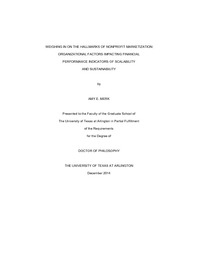| dc.description.abstract | Nonprofit organizations have experienced continued revenue growth despite a decrease in government funding, increase in competition among organizations, and greater accountability to both public and private funders. Influences from both the public and private sectors have led to a "marketized" nonprofit sector, adapting tools from the business world to succeed in a more competitive atmosphere. A nonprofit manager must demonstrate the sustainability and scalability of the organization and effectively communicate organizational goals to engage a wide audience. Concurrently, a field of third-party evaluators has emerged, claiming to identify those nonprofit organizations that provide the greatest social return on investment for so-called social investors. This study examines the impact of a variety of organizational factors, such as location, revenue composition, governance, and social media branding, on financial performance indicators of scalability and sustainability. Quantitative and qualitative data were collected on 399 organizations listed on the Charity Navigator website as providing other education services. Data included information from each organization's 990 filing from 2011, information provided by Charity Navigator, and content analysis from the organization's website and social media accounts. The researcher created a Mission Statement Effectiveness Tool as well as a branding scoring tool adapted from the Brand IDEA Framework developed by Laidler-Kylander & Stenzel (2014). Multiple linear regression analyses were performed to observe the impact of the nine organizational factors on three separate dependent variables: Charity Navigator's Financial Health score, Financial Capacity, and Revenue Growth. Mission Statement Effectiveness yielded a significant positive relationship to Financial Health. Brand IDEA Effectiveness of online content yielded a significant positive relationship to Financial Capacity and Revenue Growth. The significance of these content analysis tools identifies the impact of effective goal communication strategies on financial performance. The inconsistency observed between Financial Health and Financial Capacity also suggests the need for clarification on the use of financial performance measures as indicators of scalability and sustainability. | en_US |

